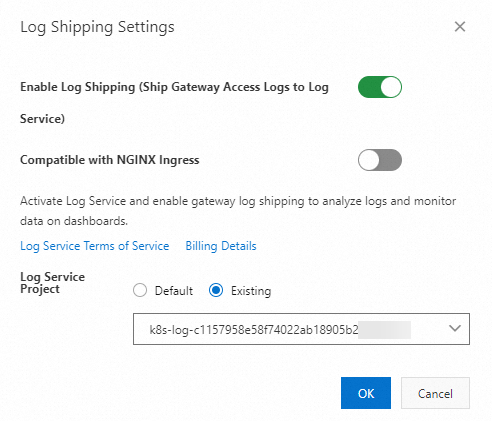The log shipping feature is implemented by using cloud-native gateways and Alibaba Cloud Simple Log Service. After log shipping is enabled for a cloud-native gateway, you can analyze the access logs of the cloud-native gateway to understand the behavior and geographical locations of client users for troubleshooting. This topic describes how to enable the log shipping feature for a cloud-native gateway of Microservices Engine (MSE).
Prerequisites
A cloud-native gateway is created. For more information, see Create a cloud-native gateway.
Simple Log Service is activated. To activate Simple Log Service, log on to the Simple Log Service console with your Alibaba Cloud account. For more information about Simple Log Service, see What is Simple Log Service?
If you use the log shipping feature in MSE, no log shipping fees are generated in the MSE console. Instead, you are charged the fees in Simple Log Service based on the amount of resources that you used. For more information about billing of Simple Log Service, see Pay-by-feature.
Enable log shipping
Log on to the MSE console. In the top navigation bar, select a region.
In the left-side navigation pane, choose Cloud-native Gateway > Gateways. On the Gateways page, click the name of the gateway.
In the left-side navigation pane, click Parameter Settings. In the Observability Parameters section, click
 next to Log Shipping. In the Log Shipping Settings dialog box, turn on Enable Log Shipping (Ship Gateway Access Logs to Log Service).
next to Log Shipping. In the Log Shipping Settings dialog box, turn on Enable Log Shipping (Ship Gateway Access Logs to Log Service). 
After you enable log shipping, a Simple Log Service project is automatically created in the Simple Log Service console. You can also select an existing Simple Log Service project.
If you activate Managed Service for OpenTelemetry, you can view metric data of the gateway in the Managed Service for OpenTelemetry console. For more information, see Enable tracing analysis for a cloud-native gateway.
After log shipping is enabled, click the link on the right side of Project in the Observability Parameters section. You are redirected to the Logstore that corresponds to the gateway. For more information, see Guide to log query and analysis.
Fields
The following table describes the fields that are related to log shipping.
Field name | Data type | Description |
__time__ | long | The time when the log entry was generated. |
cluster_id | string | The ID of the gateway that you purchased. |
consumer | string | The consumer name. This field is valid when consumer authentication is enabled. |
custom_log | json | The custom log, which can be used together with custom plug-ins. |
authority | string | The Host header in the request. |
bytes_received | long | The size of the request body. The size of the request header is not included. |
bytes_sent | long | The size of the response body. The size of the response header is not included. |
downstream_local_address | string | The address of the gateway pod. |
downstream_remote_address | string | The address of the client that is connected to the gateway. |
downstream_transport_failure_reason | string | The reason for downstream transfer failures. |
duration | long | The amount of time that is consumed to process the request. Unit: milliseconds. |
method | string | The HTTP method. |
path | string | The requested path. |
protocol | string | The HTTP protocol version. |
request_id | string | The ID of the request. The gateway generates an ID for each request and adds the ID to the |
requested_server_name | string | The server name that is used to establish a Secure Sockets Layer (SSL) connection. |
request_duration | long | The response time (RT) of requests received by a gateway. |
response_code | long | The returned HTTP status code. |
response_flags | string | The reason for request failures. |
response_tx_duration | long | The RT of responses received by a gateway. |
route_name | string | The name of the route. |
start_time | string | The start time of the request. Specify this parameter in the Universal Time Coordinated (UTC) format. |
trace_id | string | The trace ID. |
upstream_cluster | string | The name of the cluster where the upstream service resides. |
upstream_host | string | The IP address of the upstream service. |
upstream_local_address | string | The address that is used to connect to the upstream service. |
upstream_protocol | string | The protocol that is used when a request is sent to the backend service. |
upstream_service_time | long | The amount of time (in milliseconds) that is taken for the gateway to access the network of the upstream service and for the upstream service to process requests. |
upstream_transport_failure_reason | string | The reason for the failure of the connection request to the upstream service. |
user_agent | string | The User-Agent HTTP request header. |
x_forwarded_for | string | The |
ext_authz_status_code | long | The status code of custom authentication services. |
ext_authz_duration | long | The RT of custom authentication services. |
ai_log | json | The log that is used to store AI-related observability data. |
Causes of request failures
The cause of a request failure is identified by Response_Flag in the log. This section describes the values of Response_Flag.
The downstream service refers to the client, and the upstream service refers to the backend service.
UH: No healthy upstream host is available in the cluster where the upstream service resides.
UF: The connection to the upstream service fails.
NR: No route is configured for the given request.
URX: The request is rejected because the retry condition for upstream HTTP requests is not met or the maximum number of TCP connection attempts is reached.
NC: The cluster where the upstream service resides cannot be found.
DT: The request or connection duration exceeds the duration specified by
max_connection_durationormax_downstream_connection_duration.DC: The connection to the downstream service is terminated.
LH: The local service does not pass the health check.
UT: The request of the upstream service times out.
LR: The connection is locally reset.
UR: The upstream service is remotely reset.
UC: The connection to the upstream service is terminated.
DI: Request processing is delayed. The delay period is specified in the fault injection rule.
FI: The request is terminated due to the status code specified in the fault injection rule.
RL: The request is locally limited by the HTTP rate limiting filter, except for the 429 status code.
UAEX: The request is rejected by the external authorization service.
RLSE: The request is rejected because of an error in the rate limiting service.
IH: The request is rejected because an invalid value is included in a strictly checked header.
SI: Idle timeout occurs on a stream.
DPE: An HTTP protocol error is reported for the downstream service request.
UPE: An HTTP protocol error is reported for the upstream service response.
UMSDR: The processing duration of the upstream service request exceeds the maximum processing duration.
OM: The request is terminated by the overloaded manager.
DF: The request is terminated due to a DNS resolution failure.
